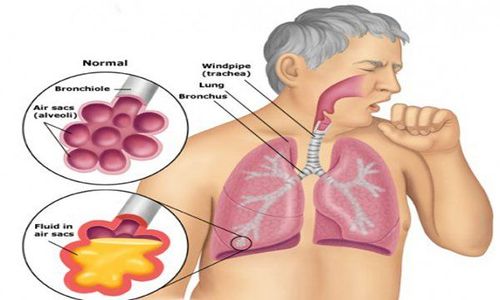This is an automatically translated article.
Isoniazid medicine 150mg is made in the form of tablets, the main ingredient is Isoniazid. The drug is used in the prevention and treatment of pulmonary tuberculosis and extrapulmonary tuberculosis.
1. What is the effect of Isoniazid?
Isoniazid 150mg medicine has the main ingredient is Isoniazid 150mg. The drug is active against Mycobacterium tuberculosis and some other atypical Mycobacterium species (M. bovis, M. kansasii). Regarding the mechanism of action, the drug inhibits the synthesis of mycolic acid - an important component of the cell wall of susceptible bacteria, leading to the breakdown of the TB cell wall.
Isoniazid drug kills bacteria depending on the concentration of the drug at the site of injury, the sensitivity of the bacteria. The minimum concentration of TB bacteria is 0.02 - 0.2μg/ml. Resistance of M. tuberculosis to Isoniazid occurs in a stepwise fashion. The mechanism of drug resistance may be due to bacteria genetically resistant to the drug.
Usually, resistant strains of bacteria develop rapidly if isoniazid is used alone to treat TB (but less so if it is used for prophylaxis). To prevent drug resistance, isoniazid should be combined with 3-4 other TB drugs, not alone.
Indications for use of Isoniazid 150mg:
Treatment of pulmonary or extrapulmonary tuberculosis; Treatment of pulmonary tuberculosis with primary symptoms; Prophylaxis of primary asymptomatic TB infection (recognized by changes with tuberculin skin test); Prophylaxis in persons at risk of reactivation of tuberculosis (infants, persons on corticosteroid or immunosuppressive therapy, persons from countries with highly endemic TB, living in conditions requiring prevention prevention); Prophylaxis against the spread of tuberculosis bacteria or latent tuberculosis infections diagnosed by skin reactions to tuberculin; Prophylaxis of history of tuberculosis treatment before chemotherapy; Treatment of infections susceptible to atypical mycobacteria, based on combination with active antibiotics. Contraindications to the use of Isoniazid 150mg:
People who are sensitive to Isoniazid or other excipients; People with a history of liver damage caused by Isoniazid; Patients with severe hepatitis, severe liver failure; Patients with polyneuritis, epilepsy; Lactating women use in combination with disulfiram and carbamazepine.
2. Instructions on how to use Isoniazid 150mg
Usage: Orally. Patients should take Isoniazid 150mg before eating or 2 hours after eating. If gastrointestinal irritation occurs, the patient can take the drug with a meal. Patients should use the drug at the indicated time, do not stop the drug when the disease has improved (because the infection may not have completely disappeared). Your doctor may tell you to take extra vitamin B6 while you are taking Isoniazid.
Because the 150mg tablet dosage form is not suitable for children under 6 years old, it is recommended to use Isoniazid with other dosage forms for this group of subjects.
Dosage:
Dosage for TB prevention:
Children: Use a dose of 5mg/kg/24 hours, up to 300mg/24 hours, once a day for 6-12 months; Adults: Dosage: 5mg/kg/24 hours, the usual dose is 300mg/24 hours, used once a day for 6-12 months. Dosage for TB treatment: It is necessary to use isoniazid in combination with other anti-tuberculosis drugs such as rifampicin. , Pyrazinamide, Streptomycin and Ethambutol according to the treatment regimen. Specifically:
In adults and adolescents: Co-administration with other anti-tuberculosis drugs. With Isoniazid orally 10mg/kg body weight until reaching 300mg Isoniazid, used once/day or 2-3 times/week as prescribed by the treatment regimen; In children: Co-administration with other anti-tuberculosis drugs. With Isoniazid orally 10mg/kg x 3 times/week or 15mg/kg x 2 times/week; Patients with hepatic impairment: Isoniazid should be used with caution, under the close supervision of a physician, in patients with impaired hepatic function; Renal impairment: In patients with moderate renal impairment (creatinine clearance 30-60ml/min) should be cautious when using Isoniazid; Patients with severe liver failure: Isoniazid is contraindicated; Dialysis patients: Isoniazid should be administered at the end of the dialysis session. Overdose: When using Isoniazid dose of 1.5g or more, there is a risk of toxicity; A dose of 10 - 15g can be fatal if not treated with emergency care, the usual fatal dose is over 200mg/kg body weight. Symptoms of drug overdose include: Nausea, vomiting, dizziness, slurred speech, increased reflexes, disorientation, hallucinations, blurred vision, ... usually occur within 30 minutes to 3 hours after overdose. drug use. If the poisoning is severe, the patient may experience respiratory depression and CNS depression, leading to stupor, coma, prolonged convulsions, acetonuria, metabolic acidosis, and hyperglycemia. If the patient is not treated or is not treated thoroughly, it can lead to death.
Treatment in case of overdose is to ensure adequate respiratory maintenance initially. Convulsions can be managed with intravenous diazepam or short-acting barbiturates, in combination with pyridoxine hydrochloride. If convulsions are controlled and isoniazid overdose occurs within 2 to 3 hours, gastric lavage should be performed, blood gas/blood, glucose, electrolytes, and serum urea monitored. Simultaneously, administer sodium bicarbonate infusion to combat metabolic acidosis, repeat injection if necessary. After that, treat according to the doctor's instructions.
Missed dose: If you forget to take a dose of Isoniazid 150mg, the patient should take it as soon as possible. If it is almost time for the next dose, skip the missed dose and take the next dose at the scheduled time.
3. Isoniazid 150mg . side effects
When using Isoniazid 150mg, patients may experience some side effects such as:
Common: Nausea, vomiting, dry mouth, diarrhea, epigastric pain; Uncommon: Hepatitis (yellow eyes and increased transaminases), back pain, arthralgia; Rare: Symptoms of systemic eosinophilia, toxic epidermal necrolysis; Frequency not known: Anemia (including non-regenerative anemia, erythrocytopenic and hemolytic anemia), agranulocytosis, eosinophilia, bleeding and coagulation disorders, thrombocytopenia , methemoglobinemia, Lupus syndrome, Pellagra disease, hyperglycemia, psychosis, optic neuritis, peripheral neuropathy, hyperreflexia, convulsions, optic nerve atrophy, pancreatitis , constipation, vasculitis, jaundice, abnormal liver function, alopecia, skin rash, purpura, allergic skin reactions, exfoliative dermatitis, gynecomastia in men,... Usually, the side effects of Isoniazid usually go away when the drug is stopped. However, there are also cases where these side effects persist, especially hepatitis. Factors that increase the risk of side effects of the drug include: The elderly, people with a history of psychosis, people with diabetes, liver failure, kidney failure, alcoholism, high blood urea, malnutrition, patients HIV-infected people who are taking anti-epileptic drugs such as hydantoin. Liver function should be assessed before using Isoniazid in these subjects.
To reduce the side effects of Isoniazid on the nervous system, patients should regularly take more vitamin B daily with a dose of 10mg / day. If the patient has peripheral neuritis, use vitamin B at a dose of 50mg / time x 3 times / day. If the patient has symptoms of hepatitis (nausea, anorexia, fatigue, irritability), it is recommended to temporarily stop taking Isoniazid 150mg for evaluation.
4. Note when using Isoniazid 150mg
Some notes patients need to remember before and while using Isoniazid 150mg:
Malnourished patients, people prone to diseases of the nervous system (alcohol addiction, diabetes) should take concomitantly with Pyridoxine; In patients with severe renal impairment (creatinine clearance less than 25ml/min), the dose of Isoniazid should be reduced, especially in patients who are slow metabolizers of Isoniazid; Use caution when using Isoniazid 150mg in people with porphyrinuria; During treatment with Isoniazid, if you drink alcohol or combine with rifampicin, there is an increased risk of hepatotoxicity; If the patient has pancreatitis caused by Isoniazid, the drug should be avoided; Isoniazid 150mg drug can cause mental disorders, convulsions and optic neuritis, so it should be used with caution when driving, operating machinery, working at height,...; Consider, consult a doctor before using Isoniazid for pregnant women; Isoniazid is secreted into breast milk, which may result in absorption of up to 2 mg/kg/day in the neonate. Therefore, if isoniazid is used in nursing mothers, pyridoxine should be added to minimize side effects.
5. Isoniazid 150mg . drug interactions
Drug interactions can affect the effectiveness of the drug or increase the risk of occurrence/severity of side effects. Some drug interactions of Isoniazid 150mg include:
It is not recommended to combine the use of Isoniazid with Carbamazepine because it inhibits the metabolism in the liver, increases the concentration of Carbamazepine in the blood plasma with manifestations of overdose; It is not recommended to combine the use of Isoniazid with Disulfiram because it can cause mental and motor disorders; Aluminum (salt and hydroxide) reduces the absorption of Isoniazid, so it is necessary to take these 2 drugs at least 2 hours apart; Volatile halogenated anesthetics have the potential to increase the formation of Isoniazid hepatotoxic substances. Therefore, isoniazid should be discontinued 1 week before surgery, isoniazid should be used only 15 days after surgery; Glucocorticoids (prednisolone) may reduce the plasma concentration of Isoniazid; Ketoconazole when combined with Isoniazid can reduce the plasma concentration of Ketoconazole. Should pay attention to the interval between 2 antibacterial doses of at least 12 hours, monitor the plasma concentration of Ketoconazole to adjust accordingly; Concomitant use of Isoniazid with Phenytoin may cause an overdose of Phenytoin due to decreased metabolism. Close clinical monitoring of phenytoin plasma concentrations is recommended, with dose adjustment possible during treatment, after discontinuation of treatment with Isoniazid; Concomitant administration of Isoniazid with Pyrazinamide increases the hepatotoxic effects; Concomitant administration of Rifampicin with Isoniazid increases the formation of toxic metabolites of Isoniazid, causing hepatotoxicity. This combination should be monitored. In the case of patients with hepatitis, treatment with Isoniazid should be discontinued; Concomitant use of Isoniazid with Stavudine increases the risk of peripheral neuropathy (due to increased side effects); Many cases of patients taking antibiotics have increased activity of oral anticoagulants. Risk factors include severe infection or inflammation, age, general condition of the patient,... Isoniazid 150mg is an antibacterial antibiotic, used for the prevention and treatment of tuberculosis. When using the drug, the patient should strictly follow the doctor's instructions for use and dosage. At the same time, patients should notify their doctor if any side effects occur for timely diagnosis and treatment interventions.
Please dial HOTLINE for more information or register for an appointment HERE. Download MyVinmec app to make appointments faster and to manage your bookings easily.













